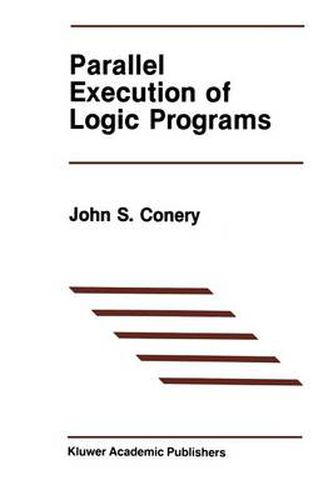Readings Newsletter
Become a Readings Member to make your shopping experience even easier.
Sign in or sign up for free!
You’re not far away from qualifying for FREE standard shipping within Australia
You’ve qualified for FREE standard shipping within Australia
The cart is loading…






This title is printed to order. This book may have been self-published. If so, we cannot guarantee the quality of the content. In the main most books will have gone through the editing process however some may not. We therefore suggest that you be aware of this before ordering this book. If in doubt check either the author or publisher’s details as we are unable to accept any returns unless they are faulty. Please contact us if you have any questions.
This book is an updated version of my Ph.D. dissertation, The AND/OR Process Model for Parallel Interpretation of Logic Programs. The three years since that paper was finished (or so I thought then) have seen quite a bit of work in the area of parallel execution models and programming languages for logic programs. A quick glance at the bibliography here shows roughly 50 papers on these topics, 40 of which were published after 1983. The main difference between the book and the dissertation is the updated survey of related work. One of the appendices in the dissertation was an overview of a Prolog implementation of an interpreter based on the AND/OR Process Model, a simulator I used to get some preliminary measurements of parallelism in logic programs. In the last three years I have been involved with three other implementations. One was written in C and is now being installed on a small multiprocessor at the University of Oregon. Most of the programming of this interpreter was done by Nitin More under my direction for his M.S. project. The other two, one written in Multilisp and the other in Modula-2, are more limited, intended to test ideas about implementing specific aspects of the model. Instead of an appendix describing one interpreter, this book has more detail about implementation included in Chapters 5 through 7, based on a combination of ideas from the four interpreters.
$9.00 standard shipping within Australia
FREE standard shipping within Australia for orders over $100.00
Express & International shipping calculated at checkout
This title is printed to order. This book may have been self-published. If so, we cannot guarantee the quality of the content. In the main most books will have gone through the editing process however some may not. We therefore suggest that you be aware of this before ordering this book. If in doubt check either the author or publisher’s details as we are unable to accept any returns unless they are faulty. Please contact us if you have any questions.
This book is an updated version of my Ph.D. dissertation, The AND/OR Process Model for Parallel Interpretation of Logic Programs. The three years since that paper was finished (or so I thought then) have seen quite a bit of work in the area of parallel execution models and programming languages for logic programs. A quick glance at the bibliography here shows roughly 50 papers on these topics, 40 of which were published after 1983. The main difference between the book and the dissertation is the updated survey of related work. One of the appendices in the dissertation was an overview of a Prolog implementation of an interpreter based on the AND/OR Process Model, a simulator I used to get some preliminary measurements of parallelism in logic programs. In the last three years I have been involved with three other implementations. One was written in C and is now being installed on a small multiprocessor at the University of Oregon. Most of the programming of this interpreter was done by Nitin More under my direction for his M.S. project. The other two, one written in Multilisp and the other in Modula-2, are more limited, intended to test ideas about implementing specific aspects of the model. Instead of an appendix describing one interpreter, this book has more detail about implementation included in Chapters 5 through 7, based on a combination of ideas from the four interpreters.